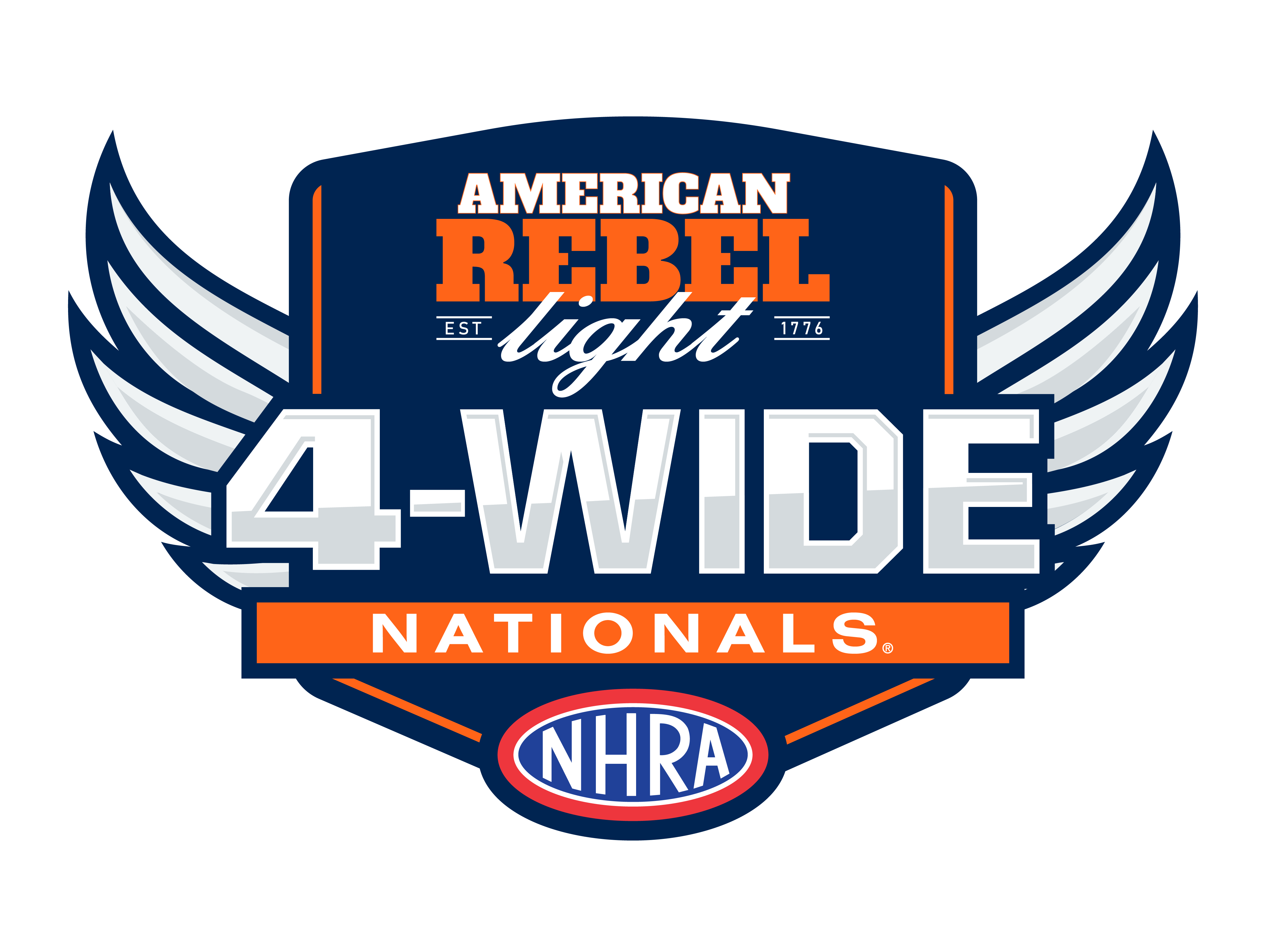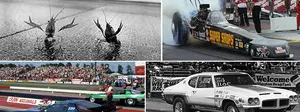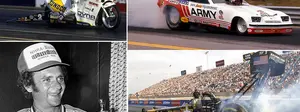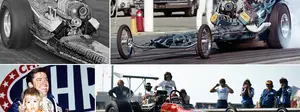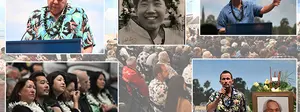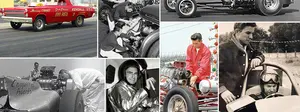

More historic horsepower haunts
By popular demand – and to begin to wade my way through the scores of requests – we're back again for another round of ghost-track hunting. As always, the vast majority of the coordinates I'll be giving you are supplied by our friends at the TerraTracks Global Authority, which has been hunting ghost tracks for years, traveling to and carefully cataloging them from starting line to the end of the race surface. We'll be using the Google Earth program to see them, so if you need a refresher course or it's your first time here, visit this previous column to get up to speed.
All right – and away we go …
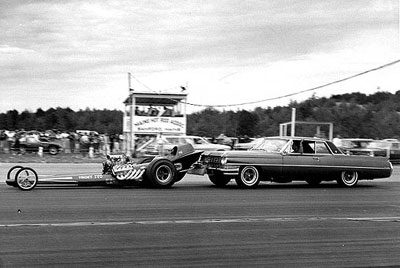 |
Ken McKenzie, who left his native New England area to move to
"It was a Air Force base with huge, long runways," he wrote. "All the top guys ran there (Garlits, Malone, Connie, etc.), and very few of the guys ever used their chutes because the runoff area was so long. Several weekends we had half-mile drags; that was fun. New England Dragway (
Well, Ken, racing still goes on at the Sanford airport, but it's far from half-mile and far from asphalt. The North East Off Road Vehicle Competition Association recently began to run there again, holding its first race Oct. 19, and the sanctioning body name should tell you what you need to know. Racing now takes place on a 300-foot-long sand track with quads and 4x4s.
Below you can see the current airport. The old drags ran on the main runway, with the starting point delineated below (43.387832, -70.717131), but I'm not sure where they're holding the sand drags. The Tommy Ivo picture above and other pics you can find here were taken by Roy Wells and are from the collection of Bruce Wheeler.
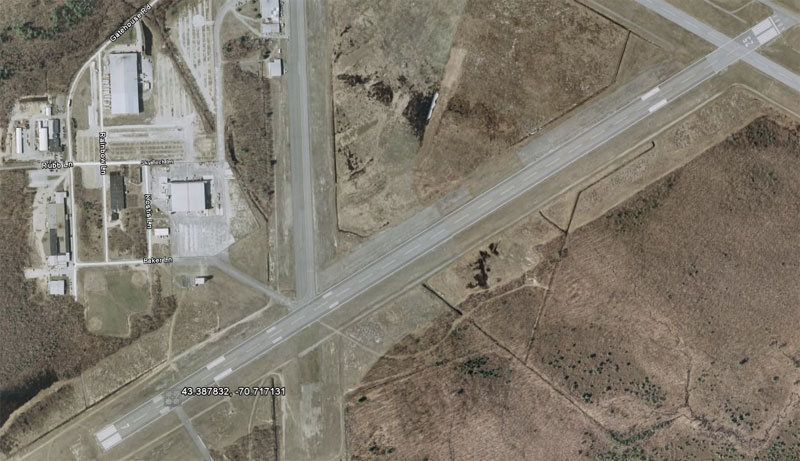 | |
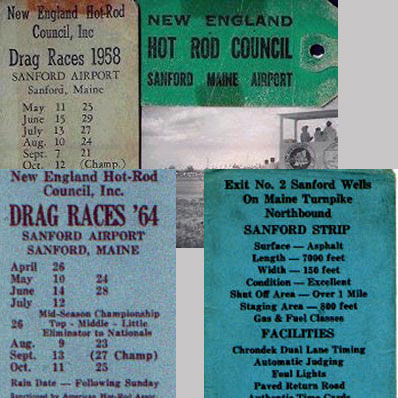 | 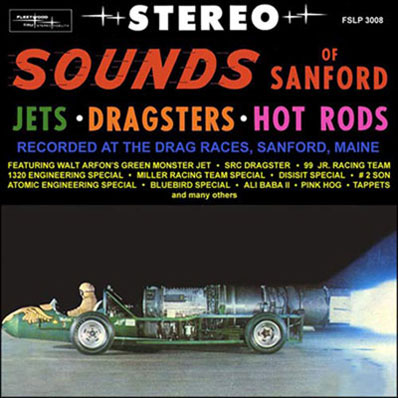 |

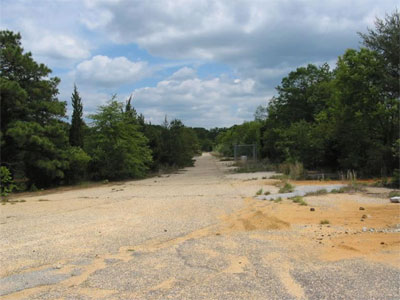 |
Sticking with East Coast requests, Rob Keister asked about Vineland Speedway in the Garden State of New Jersey. Vineland Speedway was off Delsea Drive (Route 47) in Vineland, N.J. The 55-acre facility opened April 3, 1955, with just a half-mile dirt oval that operated only through October 1957 but became a multiuse facility that included a quarter-mile dragstrip and a 1 ½-mile road course for sports cars and motorcycles that were added in 1958. Drag racing began May 10, 1958, for a four-week trial with an eighth-mile strip on the home stretch and was so financially successful that a full quarter-mile dragstrip was constructed a few months later and was visited by memorable racers including Malcolm Durham and the Tasca Thunderbolts. You can find some good historic photos here.
Everything went swell for several years, but attendance for the oval course began to flag, and the facility closed in 1966. Eventually, as seems to be the case with most ghost tracks, the track was done in by a lease. Depending on who is telling the story, either a) an unnamed
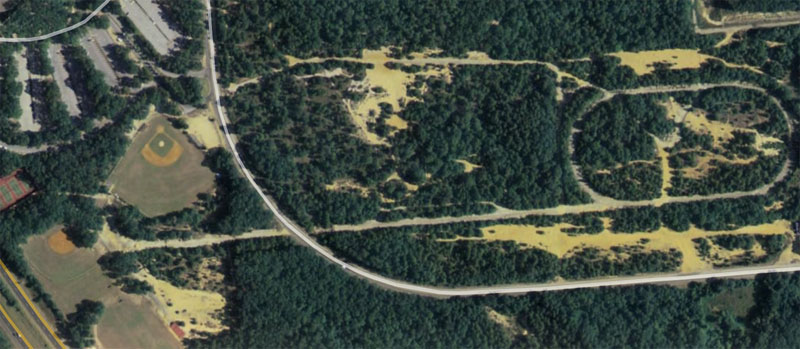 |

"Montgomery Dragstrip was my first encounter with drag racing. I was about 13 years old, and it was '59 I think, maybe '58," wrote Guy Wills. "I think it was an old airport with a traffic light for the lights and a flag starter. I have tried to get info on this track but can get none. It was in or near
There's not much info about this one either, Guy, but it does appear that Montgomery Dragstrip opened in 1959 on what is now the site of Orange County Airport, with the action taking place on what is now Runway 26, running is a general southwest direction. The starting line is noted by the coordinates 41.510061, -74.256538, the finish line by my red stripe at 41.508599, -74.260957.
 |

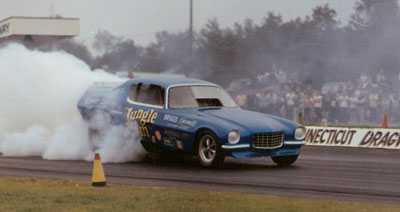 |
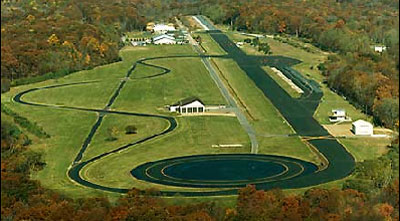 |
"A long time ago, longer now than it seems, I spent my formative years weekending at Connecticut Dragway near
"The old dragstrip hasn’t roared to life in quite a few years; as I understand it, it’s the Consumer Reports auto test track now."
Dave also turned me on to this interactive page that shows Connecticut Dragway in its new form as the Consumer Reports multiuse test track, which includes on its 327-acre lot not only a dragstrip but a handling course, avoidance-maneuver course, a skid pad, a hydroplane test area, a "ride evaluator" section, an area for brake testing, and even an off-road course for testing 4x4s. They'll test about 55 cars each year there and put each through a battery of more than 45 tests.
Dave, a quick Google images search will bring you more
 |

Suffolk Raceway was an NHRA mainstay for years and host to the popular Little Guy Nationals; the track closed in 1991 after more than 20 years of having events on an unused runway at
This past May 24, a Suffolk Raceway Reunion was held and well-attended, including by special guest Don Garlits, who ran at
Below you can get an old-time look at the track and the current airport. The starting line was in the lower left at 36.675846, -76.602696, the finish line at 36.678953, -76.600480 (about where the two runways intersect), and the end of the asphalt at 36.686622, -76.594975.
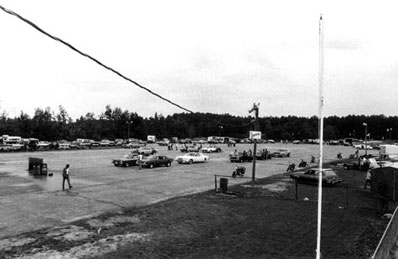 | 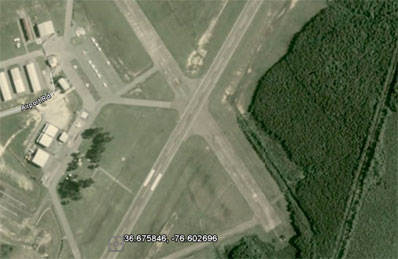 |

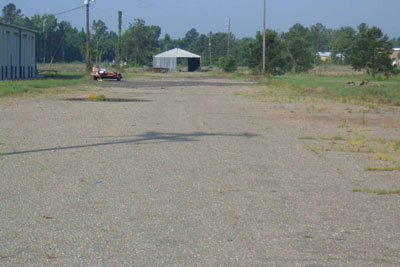 |
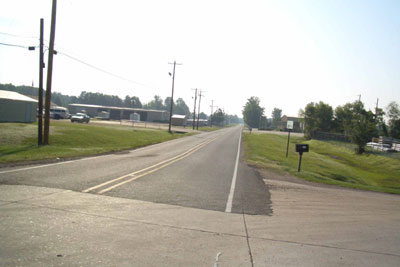 |
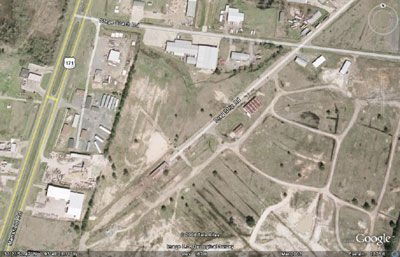 |
Internationally famous television personality and drag racing announcer Dave McClelland has a lot of ghost tracks on his résumé and dropped me an e-mail about two of them in the
"The photos of the public street are pictures of the original Old Gator Drag Strip, named Stage Coach Road. This was a street that was blocked off, and the spectators just lined the curbs to watch street-type cars make runs for close to a quarter-mile. The starting line was not far off Highway 171 (Mansfield Road), and the track ran toward the railroad tracks intersecting the street, just out of the picture frame to the right. The goal was to get slowed enough to turn before crossing the tracks ... an event that provided some interesting moments for drivers and spectators alike. While the road continued on, the track was elevated higher than the street, so it was a thrill ride cresting the tracks.
"Needless to say, there was no development close to the roadway when this activity was going on in the very late '50s and early '60s. It was quickly realized that something better needed to be built.
"That became the constructed track that has been renamed Drag Strip Lane (32.364653, -93.822355). The racing surface ran from the southwest to the northeast. The property was closed when I was there, so the photos, taken at the intersection of Stage Coach and Drag Strip Lane, are looking back toward the starting line, which was just about a quarter-mile away. Currently, several commercial firms are utilizing the property.
"The track suffered construction problems caused by an underground stream that ran across the track a few hundred feet off the line. When the rollers hit it to pack the asphalt, the surface would sink, creating a launching ramp! They went back in, dug out all of the affected area, filled with dirt from outside, and repaved. Same problem occurred, but not quite as severe.
"Couple that problem with another major one, and the second Old Gator has the distinction of having the only divisional race decided by single runs, at least that I know of. It was one of the earliest events at the track, in either '63 or '64. In an effort to save money during construction, the pits were not paved but were constructed of oiled dirt.
"Wonderful idea for wintertime, but hot weather and oiled dirt don't go together. The cars would track it onto the track, making it slick as glass. Couple that with the major dip in the track, and Division 4 Director Dale Ham and the track staff, including yours truly, decided that the Top Fuel cars would make single runs, using both lanes if necessary without disqualification ... just don't hit anything! That's the way it went -- all single-run qualifying, no side-by-side action. Jerry Baltes had low e.t. and was the winner. He and I get a big laugh out of the story every time we run into each other.
"Attempts were made to repair the problems but never worked out well, and the track closed within a couple of years. It was a shame because the track was laid out well and had a good bit of room."

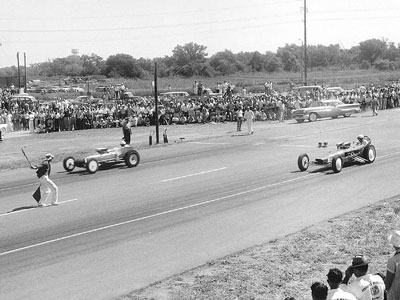 |
Venturing west, John Waters dropped me a line to report that on the state fairgrounds in
As drag racing history buffs well know, the Nationals was pretty transient in its early years, beginning in 1955 in Great Bend, Kan., then moving to Kansas City, Mo., in 1956, Oklahoma City in 1957-58 and Detroit in 1959-60 before finding a permanent home in Indy in 1961.
NHRA initially hadn't planned to move the event from Kansas City, where NHRA thought it had found a nice central home with a bigger facility than what Great Bend could offer, but the move to Missouri came in part because of hard feelings after NHRA was stuck with an unexpected $10,000 cost to repave the strip, an expense that actually contributed to keeping the Safety Safari on the sidelines in 1957.
Sponsored by NHRA in conjunction with the Oklahoma City Jaycees and the Oklahoma City Timing Association, the 1957 Nationals was a gas-only affair (during the so-called "nitro ban"), but it treated racers well. The venue boasted ample paved pits, separate participant and spectator parking, a cafeteria, dormitories ($25 for four days!), seating accommodations for thousands, and a wide and smooth dragstrip with a paved return road. Also, it was just 260 miles south of the exact geographical center of the United States. The event also tied in nicely with
According to Waters, "The starting line (35.467818, -97.566537) was moved to the east end (right side of screen) because a dragster ran into the very busy street (May Avenue) and into the business parking lot across the street." Again, my added red stripe marks the finish line (35.469077, -97.570702), and the end of the asphalt can be found at 35.470934, -97.577344.
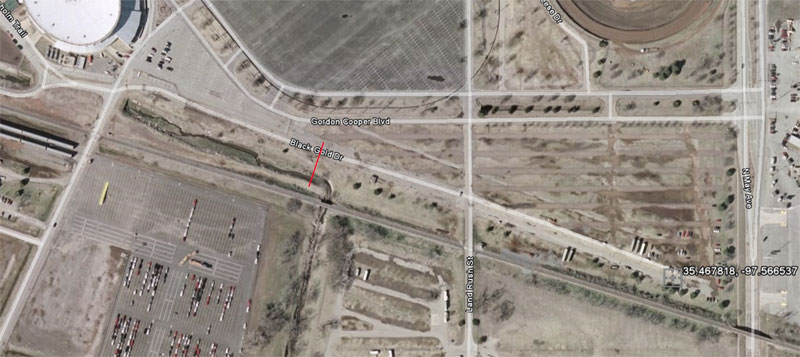 | |
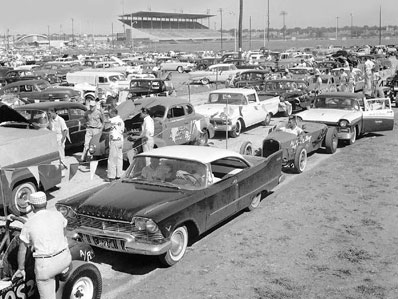 | 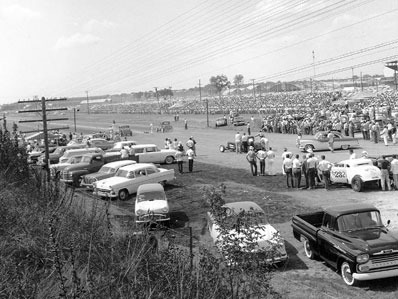 |

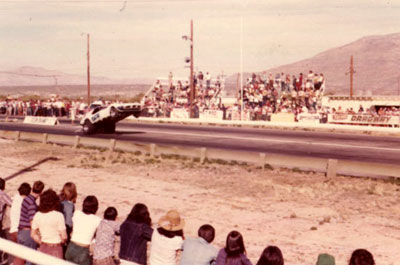 |
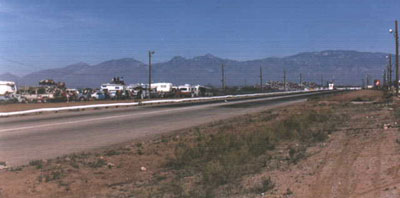 |
In the previous ghost-track installment, we covered
According to a couple of Web sites, the track was officially closed after the AHRA Winternationals in February 1985 because it reportedly was surreptitiously being used an airstrip for the delivery of illegal drugs. "The authorities found out the week before the Winternationals were scheduled. They attempted to cancel the race, but the local businesses were able to convince the authorities that the loss of revenue would be too great so the races went on. Once the Winternationals were over, Tucson Dragway was closed for good," reports one site.
The photo at above right shows the track in its heyday (that's Bob Perry's Fugitive Corvette wheelstander), and below that is a photo of how the track looked on its final day, Feb. 17, 1985, looking north toward the Catalina Mountains. You can see more pics from the track here: http://arizonaracinghistory.com/tucsondrags.
Below left is the Google Earth image of the track, which is off South Houghton road between East Poorman Road and East Valencia Road. The starting line is closest to Poorman Road at 32.132561, -110.765211, the finish line at 32.128946, -110.765209, and the end of the asphalt at 32.122369, -110.765174. Below right is a current-day shot of the track, supplied by TDI reader Kent Ewer. Below those two shots are a trio of pics that I took during Christmas 1983 that show the neglect that ultimately led to its closing. We had to hop a fence to get in, but because the Christmas Tree is still hanging above the starting line, I can’t help but think the place was still open, though that right-lane guardrail was in serious need of repair.
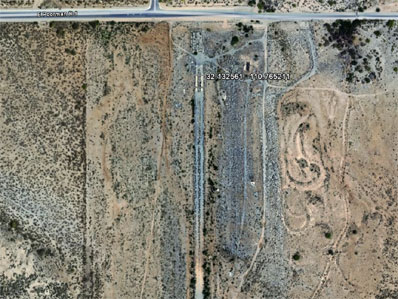 | 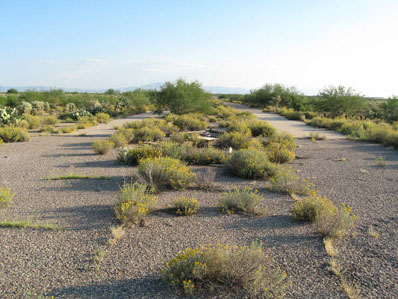 |
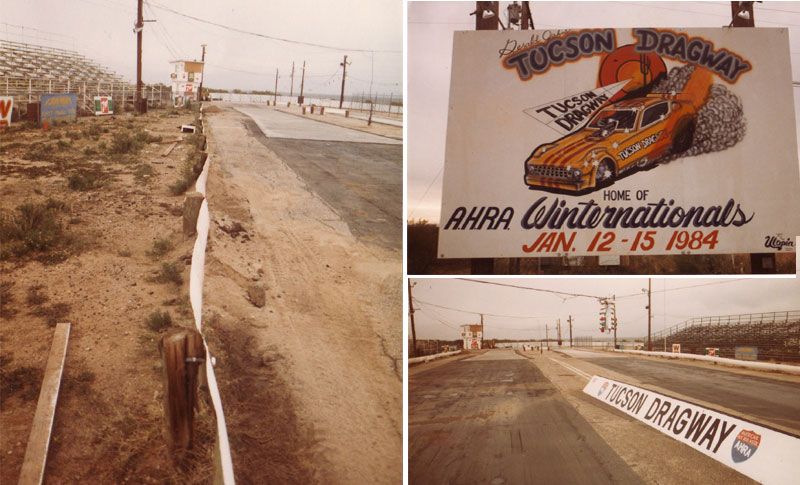 | |

And finally, completing our westward trek, we arrive in the Golden State, where Bob Huber and Mark Hayman wanted to talk about the famed old Goleta, Calif., track where many historians, beginning with Bob Post in his authoritative book High Performance, have said that organized drag racing actually was born in April 1949 in a high-stakes match on a half-mile of road leading into the local airport between West Coast heroes Tom Cobbs and Fran Hernandez (won by Hernandez's Merc-powered '32 Ford three-window by a car length).
What made this race at
 |
Researching this, I stumbled across an interesting claim by Greg Cunningham, owner of Cunningham Rods, who says that not only was he there that day, but he also had the first tube-chassis "dragster" to make an appearance at an organized drag race. Powered by a four-cylinder Ford with a four-port Riley head, it was driven by Jim Kavenaugh, who described it as a set of tube "rails" with "an engine, a piece of aluminum for a firewall, a seat, a roll bar, and four wheels." At right is a drawing of the car.
According to a story on Cunningham's Web site, "It also had the dubious distinction of being the first dragster that crashed at the dragstrip. After arguing with the organizers of the race for hours, who did not want to let the car run and blocked it from running by saying 'there was no place to put the number,' it was resolved that they would paint the number on the tire, which they did. Cunningham got the car lit off, and Kavenaugh brought it to the line and made his pass. But when he was toward the other end, the throttle stuck wide open. There was a kill switch on the firewall, but he couldn't reach it because he was wearing an improvised seat belt. There was another problem. The kill switch was a war-surplus item that was 'off' in the center position but was 'on' in both the up and down positions. When Kavenaugh lunged forward to flip the switch off, he knocked it right through the center off position to the bottom on position, so the car never shut off, and in the motion of lunging, he lost control of the car, which got sideways, flipped three times in the air, and landed on its wheels in the drainage ditch beside the raised-bed two-lane road which was the dragstrip."
Below is a shot of the old location at the Goleta airport, with the starting line (34.432312, -119.833055) marked with those coordinates and the finish line (34.430348, -119.836742) marked by the white stripe on my red rectangle. The end of the asphalt is way off my pic, but it's at 34.425665, -119.844668. According to TTGA reps, our image of
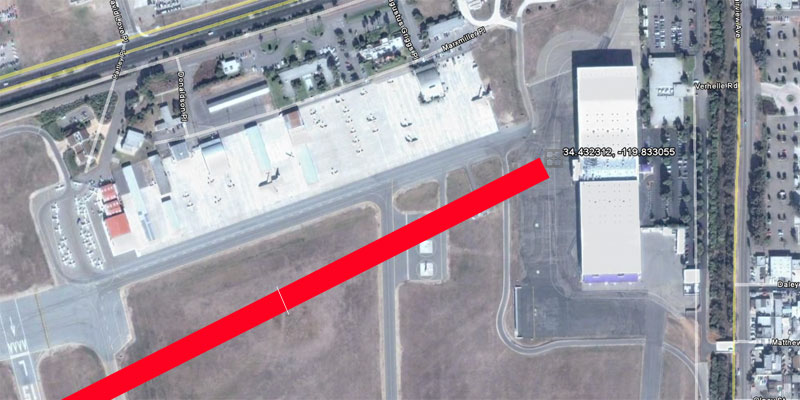 |
Okay, that's all the ghost-track hunting we have time for today. Thanks again for taking the ride.







